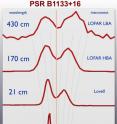Pulsars in many octaves
A unique combination of telescopes allowed astronomers to simultaneously observe the radio wavelength light from six different pulsars across wavelengths from only 3.5 centimetres up to 7 metres - a difference-factor of 200, providing an unprecedented view of how radio pulsars shine. For this world record in wavelength coverage, the international team, including scientists from the Max Planck Institute for Radio Astronomy, used the new European LOFAR telescope, in combination with two of the world's largest radio telescopes, the 100 metre Effelsberg telescope in Germany and the 76 metre Lovell telescope in the United Kingdom. Pulsars are rapidly rotating neutron stars, which measure only about 20 kilometres across and yet are more massive than the Sun. They produce beams of radio light from their magnetic poles, which are observable over a wide range of wavelengths. For the last 40 years astronomers have been studying pulsars and have been getting closer to understanding the mechanism that generates these intense beams. They hypothesize that the emission seen at the different wavelengths emerges from different heights above the highly magnetized pulsar surface. Emission seen at a particular radio wavelength therefore provides a slice through the pulsar's surrounding "magnetosphere" (magnetized atmosphere).
Astronomers believe that pulsar emission at different radio wavelengths may be created at different heights above the star's magnetic poles. The magnetic field lines that accelerate particles spread apart as one moves further and further away from the pulsar's surface. Experimental support for this hypothesis is the observation that the pulses of some pulsars become stretched out at long wavelengths (Fig. 1). The shape of the pulsar's pulsed emission is seen to evolve quite drastically as a function of wavelength and maps the spreading of magnetic field lines above the pulsar's magnetic poles.
With any single telescope, a pulsar can only be observed in a relatively narrow range of wavelengths at any given time. By combining the traditional large Effelsberg and Lovell telescopes, observing at wavelengths of centimetres, with the next generation telescope LOFAR, observing at wavelengths of meters, the astronomers were able to observe a set of six pulsars, each simultaneously across a range of nearly 8 octaves. "For comparison, consider that we have simultaneously observed these pulsars over a range equivalent to all the tones spanned by a piano," says Jason Hessels of ASTRON Netherlands Institute for Radio Astronomy. "By simultaneously observing these pulsars at such a wide range of wavelengths, we can make many snapshots of what the pulsar's emission looks like at a range of heights above the star's magnetic poles," he adds.
Key to these observations was the use of the new LOFAR telescope, which has a collection of thousands of radio antennas in stations that are centred near Exloo, in the Netherlands, and that spread from there over distances of hundreds of kilometres into neighbouring countries, such as France, Germany, Sweden, and the United Kingdom. The data taken on all stations are brought together for data analysis via high-speed networks to a BlueGene/P supercomputer and powerful cluster computers at the University of Groningen Centre for Information Technology. LOFAR is operated as an integrated facility from the ASTRON headquarters in Dwingeloo, the Netherlands. The LOFAR telescope is currently being prepared for full-scale scientific observations, and the astronomers were excited to make such high-quality, pulsar measurements even in the testing phase.
Michael Kramer, director at the Max Planck Institute for Radio Astronomy (MPIfR) in Bonn, is excited about the enormous extension in wavelength coverage provided by LOFAR, of which the first international antenna station was built next to the Effelsberg telescope in Germany. "These observations show how LOFAR complements the existing radio telescopes in Europe, like the 100-m Effelsberg telescope, in an almost perfect way."
These observations have the primary goal of better understanding how pulsars pulse. However, there is also much to be learned beyond studying just the pulsar itself. "Not only do such observations give us a fantastic handle on understanding the emission of pulsars, they are also a powerful probe of the interstellar gas that is between us and the pulsar," says Ben Stappers of the University of Manchester.
"We are really excited to have the first international LOFAR station operating here in direct vicinity to the giant 100m Effelsberg radio telescope", says Kosmas Lazaridis from MPIfR. "The combination of both, large parabolic dishes for the centimetre regime, and new digital technology for the longer wavelengths provides a wealth of new data for our pulsar research programs."
The LOFAR telescope, spanning more than 1000 kilometres in Europe, will be completed in the next year and will be the most powerful telescope on Earth for observing the Universe at the longest possible radio wavelengths visible from the Earth's surface: 1-30 metres. It is expected that this will produce a flood of exciting new scientific results.
Source: Max-Planck-Gesellschaft
Other sources
- Pulsars in many octavesfrom PhysorgThu, 22 Apr 2010, 17:02:09 UTC
- Unique combination of telescopes will provide insight into how radio pulsars shinefrom Science DailyThu, 22 Apr 2010, 16:36:11 UTC
